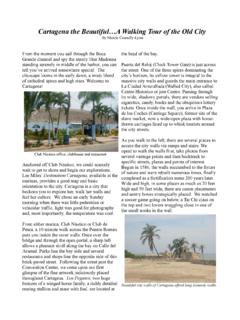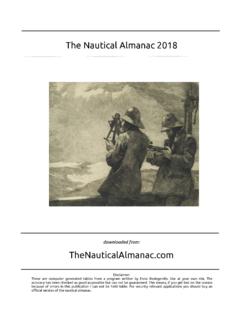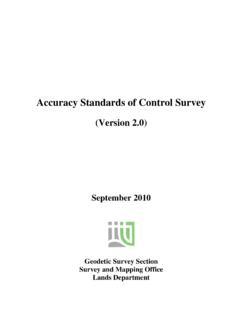Transcription of The Essential Ship’s Library - nineofcups.com
1 The Essential Cruiser s LibraryWhen we began our cruising life, we had precious little experience. We had taken a few classes on sailing and had bare boat chartered several times in Florida and the Caribbean. We did, however, have a number of very experienced friends to rely upon as we gained experience. These good friends, the Dashews, Pardeys, Calders, and Cornells to mention a few, also helped us out of more than a few ticklish situations. In reality, we have never met these fine people, but we have read their books cover to cover. Over the years, we have put together an extensive nautical Library on board Nine of Cups and hardly a day goes by that we don t refer to at least one of them. What we would like to do is share with you what we have found to be the most useful, if not Essential , books to have aboard. Realizing the DreamWhen sailing off into the sunset was still just a dream for us, we read every book we could find that talked about the cruising life and how to realize that dream.
2 Once we bought Nine of Cups and moved aboard, we parted with most of these books. We only mention them because they did make it seem possible to sell up and sail . We can recommend these two books: Sensible Cruising the Thoreau Approach by Casey and Hackler. A good book selling the simpler is better approach, especially if that means you can start sooner Sell Up and Sail , by Bill and Laurel Boat/Cruising Reference Books Offshore Cruising Encyclopedia by Steve and Linda Dashew. As the title suggests, this book is a compendium of information on boats and how to live aboard. We refer to it less now than in our first years of cruising, but still often enough that we wouldn t part with it. World Cruising Routes by Jimmy Cornell. This is a great book for planning passages everything from a trip to the Bahamas to a circumnavigation. It gives winds and currents throughout the world, as well as best times and routes for passages.
3 Cruising Handbook by Nigel Calder. A great reference book that covers everything from selecting the right boat to detailed descriptions of most of the onboard systems of a modern cruising and RepairIn addition to the specific repair manuals for the equipment aboard, we recommend the following: Boatowners Mechanical and Electrical Manual and Marine Diesel Engines , both by Nigel Calder. If you plan to leave the marina, you need to know the basics about repairing the mechanical and electrical systems aboard. These books are probably the two most used books aboard Nine of Cups. (You can tell by all the greasy fingerprints all over them.) They not only describe how most of these systems work, but how to repair them. This Old Boat by Don Casey. While it is basically intended as a book for restoring an older boat, it is also a great collection of tutorials on a variety of boat projects such as upgrading, repair and maintenance of fiberglass, paint, varnish, canvas, electrical, refrigeration and much more.
4 In addition, his writing style makes it an enjoyable read. The Complete Canvasworkers Guide by Jim Grant. A collection of tutorials on boat canvas projects such as biminis, dodgers, sail covers, and canvas repair, etc. Sail and Rig Tuning by Ivar Dedekam. A short concise book that does exactly what its title The Annapolis Book of Seamanship by John Rousmaniere. This book, a classic, covers the basics of sailing, navigation, boat handling and seamanship. Navigation There are two important points we would like to make on the subject of navigation. First, while we do have electronic charts aboard, we use them primarily for route planning and setting waypoints. When we are sailing, our preference is to use paper charts for navigation. Part of the reason for this is that our electronic charts are on our laptop, and it rarely leaves the safety of the nav station when we are underway.
5 The last thing I want to do when we are approaching a new harbor or landfall is leave the helm and go below to figure out where we are. This is our preference, and certainly many other very experienced sailors depend primarily on electronic charts for navigation and use the paper charts for backup. One thing that we do find disturbing however, is that more and more, we meet cruisers who have opted to go entirely electronic and have no paper charts aboard. This, we feel is a mistake. It s like throwing out the compass because you have a GPS aboard. The second point concerns coastal navigation skills. With the reliance on electronic charts and the GPS, many sailors have forgotten, or worse, never learned the basics of coastal navigation. This is a serious mistake for two reasons. One reason is the small but real possibility of losing all onboard electronics due to a lightening strike.
6 A much more important reason is that once you leave the or Europe, many if not most charts, have never been updated since the advent of satellite navigation. Your GPS will give you your exact location within a few feet, but since the chart was made before this accuracy was possible, it may be as much as a mile or more off. There have been numerous times when the GPS position as plotted on either the paper or electronic chart put us high and dry on an island when we were most certainly afloat. What is worse is when the GPS shows us in safety, well offshore, while it is obvious we are approaching a shoal or rock. Because of this, it is important to at least be able to find your position using the classic coastal navigational skills. The following books do a good job on the subject: American Practical Navigator by Nathaniel bowditch . This is the classic book on the subject, now made available by the National Imagery and Mapping Agency.
7 Practical Navigation for the Yachtsman , by Frederick Devereux. Weather Weather Predicting Simplified by Michael Carr. A good tutorial on weather prediction using weather faxes and satellite photos. Annapolis Book of Seamanship by John Rousmaniere. This book, already mentioned under Seamanship , has a good chapter on weather forecasting using clouds, winds and barometer. Heavy Weather Sailing by Adlar Cole. A portion of this classic is devoted to real storm condition situations and how they were handled. The remainder of the book contains expert advice on coping with heavy weather. MedicalWhen we began looking for a good medical reference, we found a lot of first aid type books that teach how to best handle an emergency situation until the ambulance arrives. We also found several medical books that seemed aimed at a trained medical professional in an isolated environment, a rural family physician or ship s doctor.
8 Neither type of book fit the bill for our needs. The following two books, however, have been of considerable use over the years: The Onboard Medical Handbook by Paul Gill. Jr., This book was written for non-medical professionals, and covers most of the health related issues you are likely to encounter aboard. It also includes a section on stocking the medicine chest. The Merck Manual of Medical Information Home Edition . A large compendium of medical information. The original version of this book was written for health care professionals, but the home edition has been rewritten for non-professionals. Also has a section on over-the-counter and prescription drugs, including generic names, uses and Reference BooksThe following are books we use frequently: A good dictionary The World Book Encyclopedia on CD. This is too large to have in book form, but great for reference on the computer.
9 Hoyle s Rules of Games , edited by Morehead and Mott-Smith. The rules and strategies for most card games and games of chance. We frequently play a quick game of gin, cribbage or canasta to start or end the day. Current score: David: 1190 games, Marcie: 1165 games. Hoyle settles all arguments! The Pocket Reference , edited by Thomas Glover. David s little black book that contains hundreds of pages of facts and formulae on all sorts of things. Want to know how large a spool you need to hold 300 feet of line, how to calculate the area of a polygon or how to convert from cables to feet? It s in there. Astronomy a good reference to the skies. We have one for both the northern and southern hemispheres Flags. A book with the flags of all the world s countries so you can identify all the boats in your anchorage. World Atlas. We have one but won t mention the name because we want a better one.
10 National Geospatial-Intelligence Agency listing of charts. A mouthful, but this is the listing by region of all the world s charts printed by the There is a catalog for each of nine regions and the catalogs are free (shipping is not). They are available from any chart dealer in the or on-line at .The following are several general reference books on birds, mammals and shells of the world. In addition, we often buy books for specific areas, such as the birds of Patagonia. Compendium of Seashells by Abbott and Dance. Birds of the World by Harrison and Greensmith. Guide to Marine Mammals of the World , National Audubon also have language dictionaries aboard if we are heading for a non-English speaking country. In addition to general purpose language dictionaries, the following were very useful: Spanish for Cruisers by Kathy Parsons Yachtsman s Ten Language Dictionary by Webb and MantonMarlinspike SeamanshipWhile most of us probably won t ever learn how to caulk the seams of a wooden boat or to tar a hemp lanyard, ropes still require knots, splices and hitches, and a sailmaker s needle and palm are still necessary gear aboard a modern cruising sailboat.










